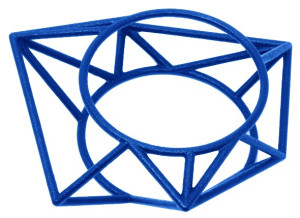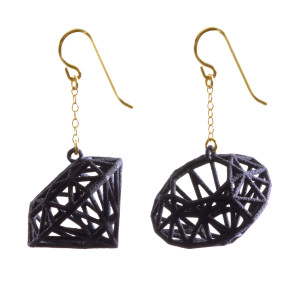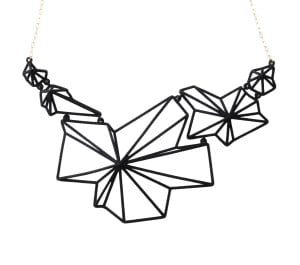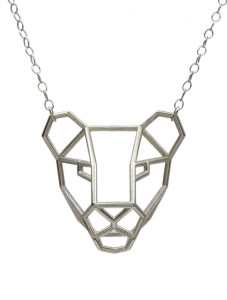
This article originates from Women In 3D Printing and is part of our effort to support the use of 3D printing technology by women. The article is re-published with permission.
Nora Toure: Summer, could you let us know about your background and what brought you to 3D printing?
Summer Powell: I’ve always loved combining art and technology, and remember creating ascii pictures in high school with an early PC. The first Macs came out when I was in college. They allowed such amazing freedom to create and experiment with graphics and typography, I decided to major in graphic design to explore this new technology. Being at the intersection of art, design, technology, and business was exciting to me. During grad school at Cranbrook Academy of Art, I continued on the path of merging art and tech, co-creating “Techtoos, Temporary Technological Tattoos,” fun wearable tech for club kids. Shortly after, I was pioneering in another emerging technology – the web. I worked as a digital designer at a number of New York agencies, just as web design was really emerging as a medium and a profession.
Later, I co-founded my own design firm, Elevator, and we designed everything from digital experiences, to corporate identities, to books, to lenticular media kits, to furniture. Years before the emergence of the iPhone, I co-created high tech watch utilizing a high-resolution screen to tell you the time and entertain you with filmic, graphical movies.

First reading about 3D printing in the early 2000’s, I was very excited about it – the idea of creating something in 3D, and being able to hold it in my hand soon after. It took quite years for the technology to become inexpensive and accessible enough for me to start using it. At that time, I was in the thick of the Bay Area maker movement, and frequenting the first TechShop, when Shapeways appeared as an affordable and high-quality 3D printing solution. After quickly learning Rhino and creating my first 3D print, I was addicted! Shortly after that, I developed my line of 3D printed fashion jewelry.

Nora Toure: Do you remember your first 3D printed design?
Summer Powell: I was learning Rhino, and tasked myself with creating a wireframe diamond as an exercise – it seemed like it would make a cool piece of jewelry. I was surprise and excited when the print arrived in the mail, and was the perfect size and shape to make a fantastic earring. I realized at that time that this idea had potential, and was the seed of a unique and transformative jewelry concept.
Nora Toure: What inspires you to create?
Summer Powell: Many things inspire me! I can be inspired by anything from the intricate lines of an art deco wrought-iron gate in front of a San Francisco row house, to the digital typeface of alarm clocks. Once when I was on Isla del Sol on Lake Titicaca, I saw this wonderful Inca structure with a pattern cut into the side.SP1 It looked like a very pixelated inverse ziggurat – simple, geometric and fascinating. I love the way the art and sacred symbols of many cultures can look so modern. The Inca carving inspired me to make a kind of Super Mario-style pixelated heart pendant that creates moirés as you view it from different angles. As I walked through Art Basel last year, I saw some incredible geometric paintings. I was already in the process of creating a very Tron-like necklace with similar forms, and it was interesting to see the similarity between the forms of the painting and those of my necklace. Certain forms just seem to emerge within our culture at a particular time, as some kind of cultural zeitgeist. I love to mix ancient and modern, low and high tech, spiritual and scientific, organic and artificial.
Nora Toure: Why using 3D printing for your creations?
Summer Powell: I love the freedom and versatility of 3D printing for creating innovative, sculptural and precise 3D shapes. The selective laser sintering process is especially liberating – it’s fantastic to be able to create an object without worrying about overhang or support materials, and to be able to create interlinking shapes. It’s also great that you can prototype your design so quickly and easily. And in my case, I’ve been prototyping in the same technology I’ve been manufacturing in, so that makes it especially easy. I especially enjoyed using SLS 3D printing when designing my Andromeda necklace. The necklace is comprised of several interlinking pieces. It still amazes me that the necklace comes out of the machine already interlinked; there was no other way to manufacture such a design. I love the way the pieces lay beautifully against the curves of the body.

Nora Toure: In your opinion, how could we encourage more women to become involved with 3D printing?

Summer Powell: I think you’re doing a fantastic job of showing the breadth and depth of how women are creating with 3D printing with this blog. I could imagine some other media-based methods of reaching a larger audience and showing women creating amazing things with 3D printing – What if there was a 3D printed design competition co-sponsored by Sculpteo and a leading women’s fashion blog? This could attract a lot of attention, and make more women aware of the creative possibilities of 3D printing. Or there could be a capsule collection as a collaboration between Sculpteo, a female designer working in 3D printing, and a major retailer, as a way to get women working in 3D printing into the public eye.
If you are interested in learning more about Summer and her work, we invite you to visit her collection here!
And don’t forget to join the Women in 3D Printing group on LinkedIn and Facebook

